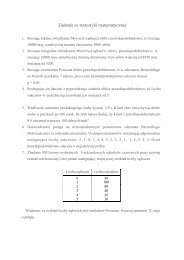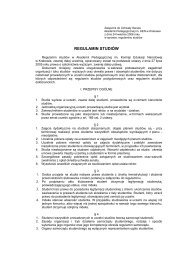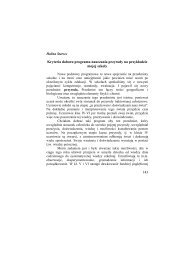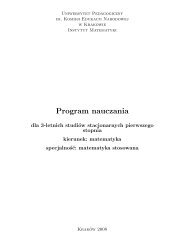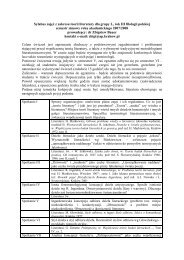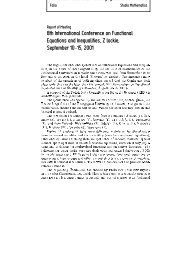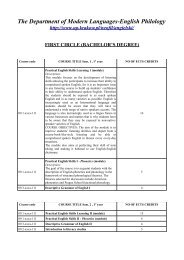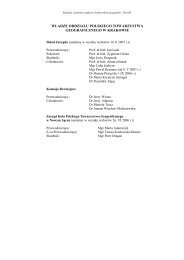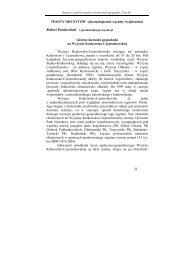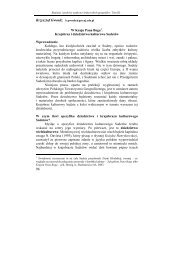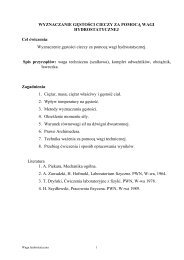Effect of Pd impurity on charge and spin density in metallic iron ...
Effect of Pd impurity on charge and spin density in metallic iron ...
Effect of Pd impurity on charge and spin density in metallic iron ...
You also want an ePaper? Increase the reach of your titles
YUMPU automatically turns print PDFs into web optimized ePapers that Google loves.
moments ordered <strong>in</strong> the ferromagnetic fashi<strong>on</strong>. A small magnetic moment has been attributed<br />
to the palladium atom <strong>in</strong> alloys c<strong>on</strong>sidered [4], however it is likely that it is due to the<br />
enhanced <strong>sp<strong>in</strong></strong> polarisati<strong>on</strong> <str<strong>on</strong>g>of</str<strong>on</strong>g> the c<strong>on</strong>ducti<strong>on</strong> b<strong>and</strong> <strong>in</strong> the vic<strong>in</strong>ity <str<strong>on</strong>g>of</str<strong>on</strong>g> the palladium <str<strong>on</strong>g>impurity</str<strong>on</strong>g>.<br />
In c<strong>on</strong>clusi<strong>on</strong> <strong>on</strong>e can make a statement that electr<strong>on</strong>s resp<strong>on</strong>sible for the magnetic moment<br />
transfer are much more localised <strong>in</strong> the system <strong>in</strong>vestigated than electr<strong>on</strong>s resp<strong>on</strong>sible for the<br />
<strong>charge</strong> transfer. The electric <strong>charge</strong> is transferred more or less directly by means <str<strong>on</strong>g>of</str<strong>on</strong>g> the<br />
c<strong>on</strong>ducti<strong>on</strong> electr<strong>on</strong>s <str<strong>on</strong>g>of</str<strong>on</strong>g> the s-type, while the local <strong>sp<strong>in</strong></strong> <strong>density</strong> is <strong>in</strong>fluenced ma<strong>in</strong>ly by the<br />
local exchange <strong>in</strong>teracti<strong>on</strong>s with the d-type c<strong>on</strong>ducti<strong>on</strong> electr<strong>on</strong>s carry<strong>in</strong>g a dom<strong>in</strong>ant<br />
c<strong>on</strong>tributi<strong>on</strong> to the <strong>sp<strong>in</strong></strong>-like magnetic moment. In other words, it seems that few electr<strong>on</strong>ic<br />
eigen-states <str<strong>on</strong>g>of</str<strong>on</strong>g> the particular wave number c<strong>on</strong>tribute coherently to the <strong>charge</strong> transfer, while<br />
many such states c<strong>on</strong>tribute to the <strong>sp<strong>in</strong></strong> transfer with<strong>in</strong> c<strong>on</strong>ducti<strong>on</strong> b<strong>and</strong> <strong>in</strong>volved. Therefore<br />
perturbati<strong>on</strong>s caused by the <str<strong>on</strong>g>impurity</str<strong>on</strong>g> have different range for <strong>charge</strong> <strong>and</strong> <strong>sp<strong>in</strong></strong> transfer,<br />
respectively.<br />
One has to be cautious while try<strong>in</strong>g to <strong>in</strong>terpret higher moments <str<strong>on</strong>g>of</str<strong>on</strong>g> the hyperf<strong>in</strong>e magnetic<br />
field distributi<strong>on</strong> obta<strong>in</strong>ed by some model <strong>in</strong>dependent method [12,13] particularly for narrow<br />
distributi<strong>on</strong>s, as distributi<strong>on</strong>s obta<strong>in</strong>ed this way may have quite artificial shapes.<br />
Birsan et al. [4] attempted recently to <strong>in</strong>troduce a c<strong>on</strong>sistent model describ<strong>in</strong>g hyperf<strong>in</strong>e field<br />
distributi<strong>on</strong> <strong>on</strong> ir<strong>on</strong> nuclei <strong>and</strong> magnetisati<strong>on</strong> data for ir<strong>on</strong>-palladium BCC alloys. This model<br />
was based <strong>on</strong> calculati<strong>on</strong>s performed previously by Drittler et al. [19]. They found n<strong>on</strong>vanish<strong>in</strong>g<br />
c<strong>on</strong>tributi<strong>on</strong>s to the hyperf<strong>in</strong>e field caused by the palladium <str<strong>on</strong>g>impurity</str<strong>on</strong>g> up to the fifth<br />
co-ord<strong>in</strong>ati<strong>on</strong> shell. However the last model seems to predict significant c<strong>on</strong>tributi<strong>on</strong>s due to<br />
the unrealistically large fields. Distributi<strong>on</strong>s were not fitted to the experimental data like <strong>in</strong><br />
this article, but calculated ex post. They applied Le Caër <strong>and</strong> Dubois method [13] to their data<br />
as well, but it seems that their hyperf<strong>in</strong>e field <strong>in</strong>terval was too coarse. The isomer shift<br />
distributi<strong>on</strong> was not taken <strong>in</strong>to account, but its impr<strong>in</strong>t <strong>on</strong> the Mössbauer data can be seen <strong>in</strong><br />
the spectra shown by them. Their samples were prepared apply<strong>in</strong>g mechanical alloy<strong>in</strong>g<br />
method, <strong>and</strong> hence they might be different from ours due to the high c<strong>on</strong>centrati<strong>on</strong> <str<strong>on</strong>g>of</str<strong>on</strong>g> defects<br />
<strong>in</strong>troduced by the method <str<strong>on</strong>g>of</str<strong>on</strong>g> mechanical alloy<strong>in</strong>g. However the basic results <str<strong>on</strong>g>of</str<strong>on</strong>g> the paper [4]<br />
are <strong>in</strong> good agreement with the present results. The average field obta<strong>in</strong>ed experimentally<br />
agrees quite well with our results <strong>in</strong> the comm<strong>on</strong> regi<strong>on</strong> <str<strong>on</strong>g>of</str<strong>on</strong>g> the palladium c<strong>on</strong>centrati<strong>on</strong><br />
<strong>in</strong>vestigated. Hence it seems essential to perform some ab <strong>in</strong>itio calculati<strong>on</strong>s <str<strong>on</strong>g>of</str<strong>on</strong>g> the electr<strong>on</strong>ic<br />
structure <strong>in</strong> the ir<strong>on</strong>-palladium system <strong>in</strong> order to get rid <str<strong>on</strong>g>of</str<strong>on</strong>g>f the dubious assumpti<strong>on</strong>s<br />
c<strong>on</strong>cerned with the arbitrary divisi<strong>on</strong> <str<strong>on</strong>g>of</str<strong>on</strong>g> the electr<strong>on</strong>s <strong>in</strong>to core <strong>and</strong> b<strong>and</strong> electr<strong>on</strong>s. The best<br />
currently available results <str<strong>on</strong>g>of</str<strong>on</strong>g> ab <strong>in</strong>itio calculati<strong>on</strong>s cannot be readily applied [5], as they were<br />
restricted to four atoms <strong>in</strong> the chemically ordered structure. They predict actually the<br />
<strong>in</strong>creased ir<strong>on</strong> magnetic moment with the <strong>in</strong>creas<strong>in</strong>g c<strong>on</strong>centrati<strong>on</strong> <str<strong>on</strong>g>of</str<strong>on</strong>g> palladium <strong>in</strong> accordance<br />
with the Mössbauer results. However this effect is overestimated <strong>in</strong> comparis<strong>on</strong> with the<br />
experimental data provided the scal<strong>in</strong>g law applies between the magnetic moment <strong>and</strong> the<br />
hyperf<strong>in</strong>e field, as no direct calculati<strong>on</strong>s <str<strong>on</strong>g>of</str<strong>on</strong>g> the ir<strong>on</strong> hyperf<strong>in</strong>e magnetic fields were performed<br />
[5]. The scal<strong>in</strong>g law might be questi<strong>on</strong>able as calculated ir<strong>on</strong> magnetic moments [5]<br />
reproduce experimentally determ<strong>in</strong>ed ir<strong>on</strong> moments quite well [4].<br />
Cheng et al. [20] performed recently c<strong>on</strong>versi<strong>on</strong> electr<strong>on</strong> Mössbauer measurements <strong>on</strong> th<strong>in</strong><br />
layers composed <str<strong>on</strong>g>of</str<strong>on</strong>g> ir<strong>on</strong> <strong>and</strong> palladium. Their results cannot be directly compared with the<br />
results obta<strong>in</strong>ed us<strong>in</strong>g alloys due to the significant modificati<strong>on</strong> <str<strong>on</strong>g>of</str<strong>on</strong>g> the c<strong>on</strong>ducti<strong>on</strong> b<strong>and</strong> <strong>in</strong><br />
almost two-dimensi<strong>on</strong>al systems. However they found very similar behaviour <str<strong>on</strong>g>of</str<strong>on</strong>g> the isomer<br />
shift <strong>and</strong> hyperf<strong>in</strong>e field seen by the ir<strong>on</strong> nucleus <strong>in</strong> the vic<strong>in</strong>ity <str<strong>on</strong>g>of</str<strong>on</strong>g> the palladium impurities.<br />
10



